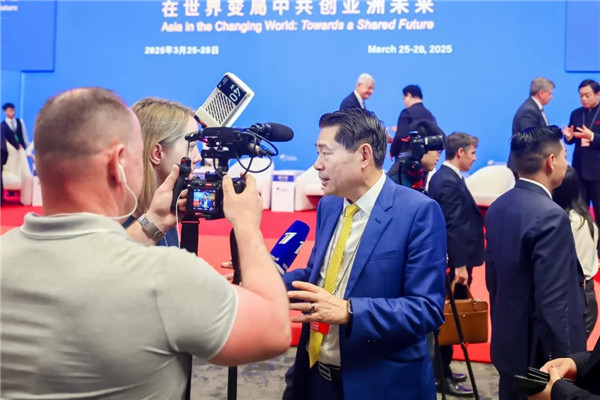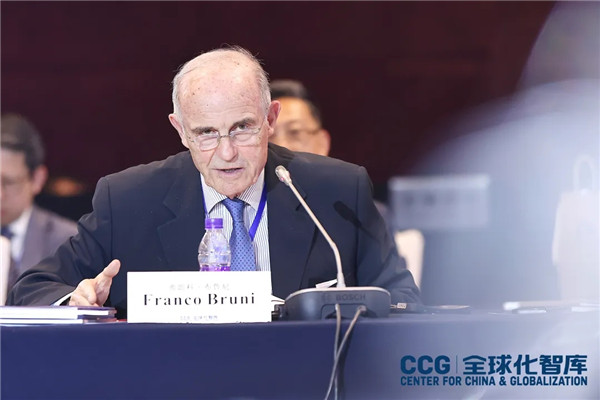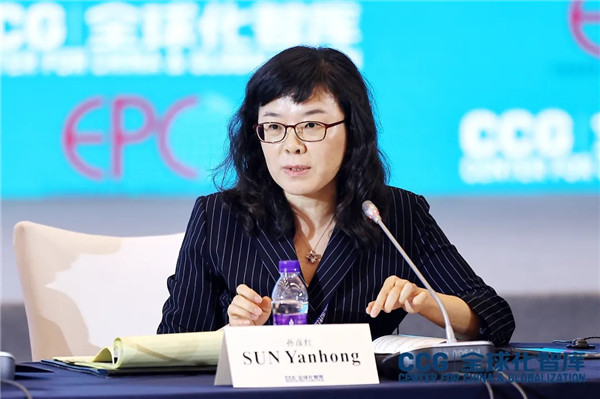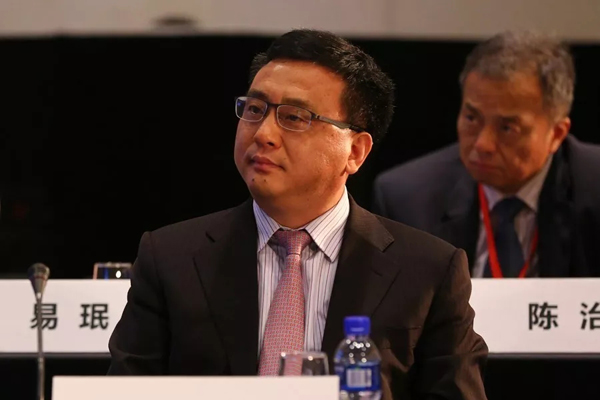世贸组织副总干事Alan Wolff在CCG线上会议呼吁加强全球政策协调以应对新冠挑战(附演讲全文 )
2020年4月23日2020年4月20日,全球化智库(CCG)举办了国内首次以新冠肺炎疫情下的WTO为主题的线上研讨会,邀请了数位国内外知名权威专家学者就相关话题展开对话。会上,世贸组织副总干事Alan Wolff强调了全球政策协调对确保向受疫情影响国家提供足够的药品和医疗产品的重要性。他表示,在抗击疫情中关于医疗卫生防护用品的供给方面,市场的无限制性竞争以及无协调性的政府干预,都不是解决问题的有效方法。
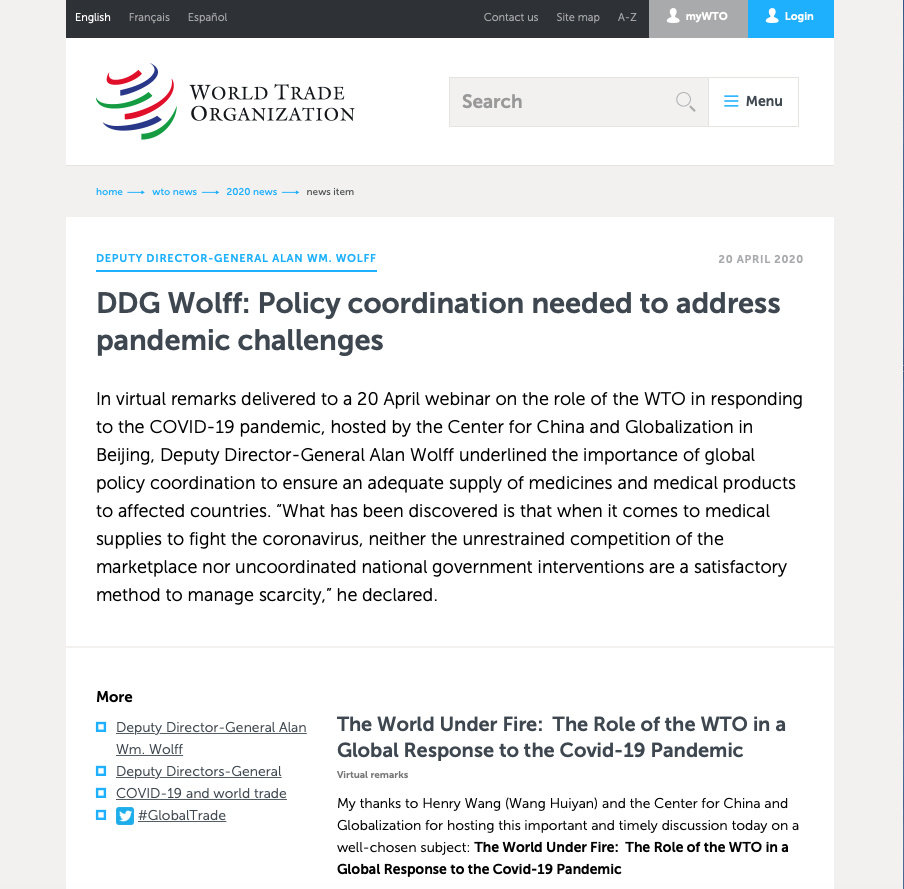
WTO副总干事Alan Wolff先生于4月20日在全球化智库(CCG)线上会议发表的演讲全文已被WTO刊登在WTO官网
https://www.wto.org/english/news_e/news20_e/ddgaw_20apr20_e.htm?utm_source=dlvr.it&utm_medium=twitter
以下为WTO副总干事Alan Wolff先生的演讲全文:
My thanks to Henry Wang (Wang Huiyao) and the Center for China and Globalization for hosting this important and timely discussion today on a well-chosen subject: The World Under Fire: The Role of the WTO in a Global Response to the Covid-19 Pandemic
Covid-19 attacked our world as if it were an extra-terrestrial. The form it took was that of a pathogen. The assault was not recognized immediately by governments as a threat, as a pandemic. No international organization was fully prepared to organize a coordinated response in the first hours or days of the onslaught. The danger was not fully appreciated. The threat did not manifest itself to all countries at the same time. Countries responded individually. Health ministers were the first responders. Finance ministers quickly followed. Trade ministers would come to play a role as well.
It is not surprising that the WTO, created 25 years ago, and the multilateral trading system, created nearly 75 years ago, did not have a packaged, ready-made, off-the-shelf response to a pandemic. There had been nothing this lethal, this global, for one hundred years. Multilateral financial institutions were set up to respond to economic turmoil regardless of the cause and credit became more available relatively quickly. National measures, however, at least for industrialized countries. were more important. Countries, to the extent that they could afford to do so, deployed positive fiscal measures to offset in varying degrees the economic harm. Many put into effect trade measures as well.
Trade responses in more than a few instances were designed to facilitate trade, mainly through suspending tariffs on imports of needed medical supplies. Of concern, however, were 102 measures that were trade restrictive, consisting largely of export controls placed on products the supplies of which governments worried were inadequate to meet domestic demand.
The first coordinated international response came on 26 March in the form of a pledge by G20 leaders, followed a few days later by a declaration by G20 trade ministers. The G20 countries committed themselves to using measures that would be “targeted, proportionate, transparent, and temporary”. The leaders emphasized “the importance of transparency in the current environment and [committed] to notify the WTO of any trade related measures taken”. The trade ministers further agreed to assure “that emergency measures . . . do not create unnecessary barriers to trade or disruption to global supply chains and are consistent with WTO rules.”
As might be expected, the degree of conformity with these commitments has so far been mixed. Notifications have increased, so there is greater transparency. These consist of references to both forward-leaning measures favoring the freer flow of trade in medical supplies as well as trade-restrictive measures.
Transparency and Analysis
On 24 March, WTO Director-General Roberto Azevêdo asked all WTO Members to submit information to the WTO Secretariat about recent trade and trade-related measures in response to the coronavirus outbreak. Providing additional transparency is the first operational multilateral response to the pandemic. These notifications may be viewed on the WTO website. There are fewer than shown in Simon Evenett’s data on St. Gallen’s Global Trade Alert since what is published on the WTO website is limited to official notifications.
Supporting the effort to get information to WTO Members and to the public on trade measures, both trade-restrictive and trade-facilitating, was the creation of a cross-divisional WTO Covid 19 Task Force. As a result of its efforts, the WTO released its Trade Forecast on 8 April 2020. The forecast is sobering:
Member Initiatives
In the meantime, there have been several initiatives undertaken by Members.
This initiative was circulated by the Singapore Mission for others to sign on if they wished to do so.
On 15 April, Singapore and New Zealand entered into a more formal bilateral agreement to keep their markets open for medical supplies and equipment.
DECLARATION ON TRADE IN ESSENTIAL GOODS FOR COMBATING THE COVID-19 PANDEMIC 15 April 2020
New Zealand Singapore
RECOGNISING the significant contribution of trade liberalization in essential goods for combating the Covid-19 pandemic and protecting public health;
Declare:
Tariff Elimination and Implementation
● Each Participant will eliminate all customs duties and all other duties and charges of any kind, . . . with respect to all products listed ….
Export Restrictions
● The Participants will not apply export prohibitions or restrictions, … with respect to all products listed … .
Non-tariff Barriers
● The Participants will intensify consultations with a view to removing non-tariff barriers on all products listed… .
Facilitation of Trade in Essential Goods
● The Participants will …expedite and facilitate the flow and transit of all products listed … through their respective sea and airports.
● The Participants will endeavour to expedite the release of such products upon arrival [and gather information] to begin processing prior to the arrival of products.
● The Participants will endeavour … to allow free pratique to cargo ships – i.e., the permission to enter a port, discharge or load cargo or stores.
● The Participants will … endeavour to facilitate entry, transit and departure of air cargo containing essential medical supplies.
Acceptance and Expansion of Membership
● This Declaration will be open to participation by any Member of the WTO, or State or separate customs territory in the process of acceding to the WTO.
Singapore and New Zealand have circulated this text to WTO Members to facilitate others joining if they so wish.
Canada, leader of the Ottawa group of 13 WTO Members (including the European Union as one), is in the early stages of seeking support for a joint statement of interested Members to help ensure well-functioning global agriculture and agri-food supply chains.
Expected EU initiative
On 16 April, European Trade Commissioner Phil Hogan suggested that EU Member State Trade Ministers consider the EU negotiating an international agreement to permanently waive tariffs for medical goods. In the near term, he mentioned the possibility of “suspending the tariffs on most needed medical equipment” and convincing international actors to do the same. The Commission has been working to coordinate individual Member State trade measures in response to the crisis.
The G20 Finance Ministers
There was a time when Foreign Ministers and Finance Ministers were the primary drivers of liberal trade policy. It was Cordell Hull as Secretary of State who led the world toward nondiscrimination in trade through bilateral agreements in the 1930s and it was George Shultz as US Secretary of the Treasury who in 1979 with his colleagues launched the GATT Round that was the first to address successfully nontariff barriers.
On 15 April, the G20 Finance Ministers issued a communique following a virtual meeting in which they reiterated the statements of the G20 Trade Ministers. They stated their support for the availability of essential medical supplies and pharmaceuticals. They implicitly recognized the necessity – or at least the reality — that trade restrictions would be imposed on Covid-19 needed supplies —
We agree that emergency trade measures designed to tackle COVID-19, if deemed necessary, must be targeted, proportionate, transparent and temporary, and that they do not create unnecessary barriers to trade or disruption to global supply chains, and are consistent with WTO rules. We are actively working to ensure the continued flow of vital medical supplies and equipment.
They also supported their Trade Ministers’ agreement to
continue to work together to deliver a free, fair, non-discriminatory, transparent, predictable and stable trade and investment environment, and to keep our markets open.
They left it to their Trade Ministers to
identify, among other things, longer term actions that should be taken to support the multilateral trading system and expedite economic recovery.
Regarding the one trade-related action clearly within what they might have considered their mandate, they welcomed the decisions of Multilateral Development Banks to
support [the] private sector, including companies and financial institutions, notably through trade finance, liquidity and working capital programs.
Trade flows are determined much more by macroeconomic factors than by trade policy. The G20 Finance Ministers were robust in addressing this, their primary role:
We have taken immediate and exceptional measures, domestically and internationally, to address the COVID-19 pandemic and its impacts, including by implementing unprecedented fiscal, monetary and financial stability actions and ensuring that the International Financial Institutions (IFIs) can provide critical support to developing and low-income countries.
Our efforts must continue and be amplified. We commit to use all available policy tools to support the global economy, boost confidence, maintain financial stability and prevent deep and prolonged economic effects.
While macroeconomic forces determine the level of trade, trade measures can and do interfere with meeting the health and economic challenges posed by the Covid-19 pandemic. Widespread trade restrictive (or liberalizing) measures can certainly affect the trajectory of the economic recovery. That is a curve that no one should want to see flattened.
Reshoring
Reshoring is the antithesis of global specialization. It cannot coexist comfortably with a multilateral trading system founded on the principle of open markets.
One of the subjects reportedly discussed in the meeting of EU Trade Ministers on 16 April was the same issue that a considerable number of governments of large countries are considering. This is the balance to be drawn between import dependency and self-sufficiency. While a country’s own measures to assure domestic supply may not cause much concern to its authors, it does cause concern to countries that rely on foreign supplies of essential medical products (supplies, equipment and medicines). No country is self-sufficient in the full range of essential Covid-19 response related products.
What has been discovered is that when it comes to medical supplies to fight the coronavirus, neither the unrestrained competition of the marketplace nor uncoordinated national government interventions are a satisfactory method to manage scarcity.
The urge to achieve medical supply independence is manifested through a combination of export controls, pre-emptive purchasing, alleged state-sponsored seizure of goods in transit, state-mandated production and domestic industrial subsidies.
While the WTO has prided itself on giving policy space for export restrictions designed to deal with short supply, the issue at present is not policy space but lack of international policy coordination. Outside of a requirement of nondiscrimination, under the WTO rules, much is left to the discretion of the country imposing the measure. Likewise, the constraints under the WTO rules on domestic subsidies are very limited. Farther afield from the subjects considered by the WTO are aggressive purchasing, seizure of supplies, competitive bidding that excludes less affluent purchasers from the market, and state-investment or other government involvement that directs available supplies to domestic use. These are now matters of concern.
During the EU Trade Ministers’ virtual meeting last Thursday, Commissioner Hogan reportedly “stressed the importance of ‘ensur[ing] the EU’s strategic autonomy’ while noting that a full reshoring of European industries would be impossible”. He reportedly said “Strategic autonomy does not mean that we should aim for self-sufficiency. Given the complexity of supply chains, this would be an unattainable goal”. Screening foreign investment, and promoting government investment, as has been suggested by EU Commissioner Vestager, is another means of attempting to ensure sources of supply remain available, and perhaps captive.
Before the coronavirus struck, the US-China trade conflict was causing companies to reexamine the viability of their supply chains. While current pressures could lead to some re-shoring, in the first instance they would be more likely to cause diversification of sourcing. This would not occur overnight, but through shifts in patterns of investment over time. No company would willingly put all of its chips on one number on what has become something like a game of roulette. Covid-19 caused supply chains to seize up, not just because workers could not get to factories at the beginning of the supply chain, but because commercial air traffic largely ceased to exist (Singapore Airlines reportedly has only 10 out of its fleet of 210 planes in service). Markets dried up at the distribution and consumption end of the chain.
Much maligned, globalization in fact can provide resilience to the production – consumption continuum if borders remain substantially open and other government interventions do not interfere. The reassertion of the nation-state in a form at least for dealing with maintaining domestic-sourced supplies during a pandemic would be something the 17th century mercantilist Colbert would recognize and embrace as his offspring, only urging that it be applied more broadly.
For some decades of the 20th century there was a debate about the role of the state in production for commercial markets. That is coming back now in the 21st century, in terms of China seeking to promote advanced manufacturing technologies, and now in the West to deal with the pandemic. Some dirigiste policies, promoting basic research, should meet with wholehearted approval by most supporters of the modern economy. During the Korean War the U.S. government sought to create a titanium industry in order to produce fighter aircraft. It published a public notice offering to fund the creation of the industry and did so. Now the U.S. government has invoked the same era’s Defense Production Act to order production of masks by 3M and ventilators by General Motors. Other countries are also witnessing an expansion of the state. Dirigisme cannot be a sustainable policy for global growth.
Some good news
While there is a compulsory licensing mechanism in the WTO rules on intellectual property rights, that flexibility is largely irrelevant at present for two reasons. First, there is as of now no proven vaccine or other treatment for Covid-19, and secondly, when there is one, it is likely to be produced in massive quantities by numerous producers around the world.
In the meantime, the normal approach to rewarding innovation with exclusive rights has in practice been suspended by private actors. Researchers around the world are sharing data, trying to shrink the time needed to find an effective vaccine. Similarly, a major producer of ventilators has placed its design for making this essential equipment on the web, with an invitation for all to replicate the product. The proprietary instinct in both cases has been subordinated to a desire to serve the common good.
Near term priorities
Moving forward
The first step toward getting the WTO to be fully functioning again was for it to be able to convene a virtual meeting of Permanent Representatives of WTO Members. On Friday, the end of the fifth week of WTO headquarters closure, that was achieved. 250 individuals logged on to this virtual heads of delegation meeting, and 54 Members took the floor, with simultaneous interpretation in the three official languages of the WTO, French, Spanish and English. This illuminates a path forward for WTO Members’ work in regular committees and the joint initiatives on E-Commerce, Investment Facilitation, Micro, Medium and Small Enterprises, Domestic Regulation of Services and on Gender, as well as on Fisheries Subsidies, and a variety of other activities using virtual means until physical meetings are once again possible.
In the near term, a dominant subject is likely to be addressing trade measures being put into place to deal with Covid-19. The WTO generally functions on Member proposals. In these few weeks, none have yet been tabled to deal with the pandemic. The absence of formal proposals is not the same as stasis, in that monitoring, gathering and circulating information, providing analyses and Members considering joining other Member’s initiatives will take place. But multilateral agreement ultimately requires formal proposals by Members and adoption by consensus.
Agenda items for a WTO Covid 19 Response
Numerous suggestions have been made by seasoned trade experts (some of which have already been adopted by Singapore and New Zealand in their — open to all — bilateral agreement). These include:
o More comprehensive and prompt notification of measures — notification with today’s technologies can be simultaneous with promulgation;
o Enhanced monitoring to assure that data is as complete as possible;
o Tariff suspensions on relevant medical supplies, medical equipment and pharmaceuticals;
o Enhanced trade facilitation for these goods (e.g. pre-cleared green channels);
o Codes of conduct, best practices and international understandings resulting in:
■ Guidelines on allocating scarcity;
■ An accord on export controls and equivalent measures (including, e.g., pre-emptive purchasing in whatever form), which could address;
■ Specifying procedures including prior notice and consultation on their justification and how they are applied, including being nondiscriminatory;
■ Creating a process for affected countries registering specific trade, and
■ Duration of measures.
■ Best practices for sharing IP for medical supplies, equipment, as well as test data and formulae for vaccine and medications;
■ Standards (SPS and TBT) best practices during the pandemic;
■ An understanding to assure food security that does not depend on national export restrictions;
■ Facilitating cross-border movement of personnel for essential services, including medical services and farm labor;
■ Coordinated efforts to enhance manufacturing of medical equipment and supplies; and
■ Formation of a WTO Member Emergency Covid 19 Response Committee (ERC) or Task Force.
Planning of Measures to Assist in the Economic Recovery
It is not too early to consider Trade-related Recovery Measures. Those which might be of service, include:
Continuing Progress on the WTO Agenda
The work of the WTO that existed as 2020 began will need to be pursued without unnecessary delay. This includes work on:
· Concluding the fisheries subsidies negotiations;
· Finding ways forward for Agriculture;
· Moving forward on Joint Statement Initiatives re: Domestic regulation of services, Investment Facilitation, MSMEs, and Gender;
· Considering Member initiatives on the environment;
· Making permanent the moratorium on customs duties on electronic transmissions, and
· Improving notifications and transparency, including through use of digital tools.
Planning for the Future
Is the post Covid 19 world going to be different? What is likely? What will the result be of a reevaluation by the private sector and by governments of global value chains? Will governments turn to what Pascal Lamy has called “precautionnisme”, the antithesis of the dominant motivating force that led to the creation of the multilateral trading system seven decades ago. To what extent will the urge to promote self-sufficiency, onshoring spread? How is this to be accommodated or shaped? Will the pressure for a number of countries to replace lost revenues result in a widespread desire to raise tariff rates (which in the case of many developing countries can be consistent with existing WTO obligations as applied rates are now at levels well below contractually bound rates)? Will a standstill be effective to resist a wave of trade-restrictive measures or will a positive counter, a trade liberalizing initiative be necessary? Where is leadership for the multilateral trading system to be found, and how should it best be expressed? To what extent is investment in the system required by all? Is participation in the system driven to some extent by altruism or is altruism, in reality, informed pragmatism? Is it useful to discern and seek to define common purposes?
The overriding question for the world in which the WTO must function is whether the global shift toward nationalism and populism dominates, or does that trend, in evidence before the advent of Covid-19, get overridden by a return to an emphasis on international cooperation. The multilateral trading system reached something of a high plateau with the creation of the WTO. There have been pro-liberalization bright spots, or at least clearly positive steps, with the creation of the Agreements on Pharmaceutical and on Information Technology, both of which eliminated tariffs on a nondiscriminatory bases, the ban on agricultural export subsidies, and the conclusion of the Trade Facilitation Agreement. Two months ago, pre-Covid-19, while progress was being made, there was not yet sufficient reliable forward momentum for disciplining Fisheries Subsidies and bringing within the ambit of the trading system’s rules the world of E-commerce.
Surviving the pandemic can change matters for the better. The pandemic will cause the world to reach a lower level of economic activity than did the Financial Crisis. That can create an opportunity to restore international cooperation and bring institutional improvements to the WTO. There will be strong pressures in the opposite direction. That outcome of that contest of conflicting policies will rest upon leadership. It is a matter of bringing sufficient focus and energy to bear.
One concrete step toward planning for the future of the trading system would be for a WTO Committee for Policy Planning to be formed. It is necessary to assure that there is dedicated policy planning capacity within the WTO Secretariat and networked with Members, including experts in capitals who would be able to participate remotely.
